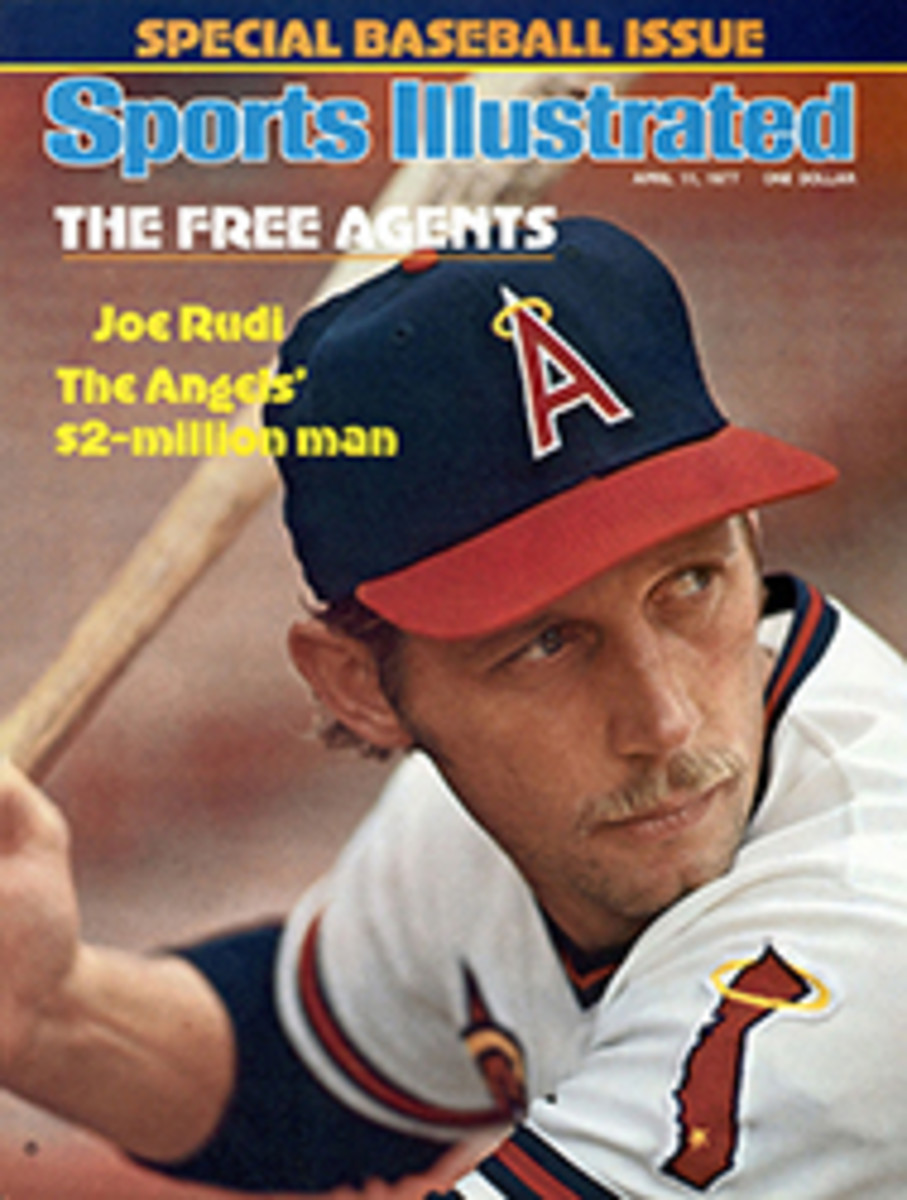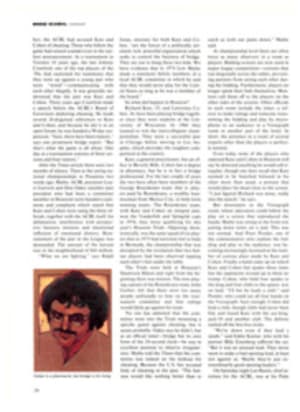
A laughing matter no longer
Edson Arantes do Nascimento—Pelé—leaped for joy in the rain that pelted the New Jersey Meadowlands. It was a mere exhibition game, but Pelé has never taken a goal he scored casually, and this was the 1,259th of his career. With some luck, he will score perhaps another 15 for the New York Cosmos in the season ahead, and that will be the end. At 36, the best-known soccer player in the world will retire, having almost single-handedly conferred credibility on the professional game in this country since he arrived here two years ago.
Pelé's last season begins with the NASL down from 20 teams to 18, financially wasted Philadelphia and Boston having been dropped and no fewer than four other franchises transferred to presumably greener pastures. Phil Woosnam, the league's eternally optimistic commissioner, claims he is buoyed by such activity. "Soccer is the only pro sport that's growing," he says. "All the big ones are leveling out, and the smart new money is going into soccer. We'll add four more teams for 78." Already signed up are the Colorado Caribous, owned by smart money men Booth Gardner of Seattle and James Guercio of Boulder. Cost of the franchise was $1 million.
Attendance, that pulse by which bankers, commissioners and team owners gauge fiscal health, was up last year to an average of 11,000 a game from less than 8,000 in 1975. The schedule has been increased from 24 games to 26. A new television contract with TVS will bring seven regular-season games, sponsored by such as Coke and Toyota, to some 140 subscriber stations across the country. Whatever local stations do is extra. The Cosmos, for instance, will televise their entire away-game schedule back to New York.
On the field, a new tie-breaking rule will probably offend soccer purists, but will provide pyrotechnics. A 15-minute sudden-death overtime period will follow a regulation tie; after that, a "shootout" will determine the winner—individual members of a side taking turns going one-on-one against the opposing goalkeeper from 35 yards out.
The rule underlines the league's determination to put an American imprint on the international sport. It also reflects a growing confidence that U.S. soccer has come of age, or near to it. "Foreign players no longer laugh at the idea of NASL soccer," says Woosnam. "Now they'll talk a deal."
One thing the NASL has not been able to laugh off is the fact that possibly its two best teams—the Cosmos and the Tampa Bay Rowdies—are again not only in the same conference (the Atlantic), but also in the same division, and thus one of them will be eliminated after the first round of the playoffs. Until then, the two clubs will likely fight to the wire for first place in the East. The Cosmos, who will perform this year at the multimillion-dollar Meadowlands sports complex, play perhaps the most sophisticated game in the league. With the savvy of Pelé and the strong shot of Giorgio Chinaglia, who led the league with 19 goals and 11 assists after he was imported last year from Italy, the Cosmos will be extraordinarily tough, even more so than before with the off-season addition of Yugoslavian Midfielder Vitomir Dimitrijevic.
In sharp contrast is Coach Eddie Firmani's galloping, rough-and-tumble, long-passing English-style Tampa club, led by Rodney Marsh, heir-apparent to Pelé as the best player in the league. Englishman Derek Smethurst, who topped the league with 20 goals last year, is again on hand, as is the burly veteran Haitian National, Arsene Auguste. The Rowdies have added Goalie Paul Hammond from England. All told, Tampa Bay may hold a delicate edge over New York in the East.
Behind these two are the Washington Diplomats, who move into 55,000-seat RFK Stadium, reflecting high hopes at the gate if not on the field. The Dips will not have the services of Forward Paul Cannell, the goalie-crunching anchor of last year's side, who chose to remain with his English first division team. Coach Dennis Viollet must mold six new English players—all signed within the last three weeks—into a team. He still should be able to overcome the Fort Lauderdale Strikers—last year's Miami Toros—who will occupy the divisional basement. Coach Ron Newman, formerly of Dallas, has his strikers taking ballet lessons for grace, but it will be a long waltz over the 26-game season.
The Northern Division of the Atlantic Conference again will be led by the uninspiring but highly competent Chicago Sting, 15-9 last season. The attack will center around Miro Rys, 19, a gifted young playmaking forward from Cicero, Ill., and veteran Polish International star John Kowolik, 33, a lightning-quick ball handler.
After their 12-12 season last year, the Connecticut Bicentennials moved south from Hartford into New Haven's Yale Bowl, with a new and strong Portuguese contingent headed by Vitor Moia, a striker from first division Estoril. The Bi's, as they like to be known, could finish second in the North.
The Rochester Lancers may come in third or even second if John Pedro, their small but magnificent midfielder, continues to improve. Mike Stojanovic, also a forward, was the NASL's fourth-leading scorer last season.
And last year's champions, Toronto's Metros-Croatia, who turned down an acquisition offer of $900,000 from Carling-O'Keefe brewery, figure to do no better than third, having failed to sign Midfielder Wolfgang Sunholtz and the "Prince of Soccer," the aging Eusabio.
St. Louis will return this year to the real world after experimenting with a heavily American line-up. The Stars finished with a 5-19 record, worst in the league. This season there are seven new starters, five of them English.
In the Pacific Conference, the Western Division will again be dominated by the youthful, slick Minnesota Kicks, the team that gave the NASL tailgate parties and free parking. Last season they were 15-9 and had the third-highest number of points in the league. They should do well again this year. Heavily staffed with English players, the Kicks will depend on African speedster Ace Ntsoelengoe, the best attacking midfielder in the league, and the recently signed Paul Futcher, 20, a young defender from England.
Minnesota could be menaced by the vastly improved Portland Timbers, who fell like so many Ponderosa pines last year (8-16), after deciding to stay with a pat hand because they made the finals in 1975. New Coach Brian Tiler quickly signed ex-Rowdies Clyde Best and Stewart Scullion, two of the league's finer English forwards; the pair had become embroiled with the Tampa Bay management over bonuses and were let go. One Rowdies owner still refers to Scullion as "that little twerp."
Vancouver should come in third in the West. Twelve Whitecaps, plus Coach Eckhard Krautzen, are members of the moderately successful Canadian National team, which played together year-round against able competition. But even with Defender Bruce Wilson—one of the best "North American" (NASL-ese for "Canadian") players, and Defender Sam Lenarduzzi, who was in his first international game for Canada's national team at 17, the Whitecaps won't wash the Timbers out to sea.
Coach Jimmy Gabriel of the Seattle Sounders is trying an experiment that could assure him of the basement in the division. Because Gabriel doesn't want to use "loaners"—English players on loan to American teams who don't want to pay for their services on a year-round basis—he is forced to rely on American players and the more modestly talented foreigners whose contracts his team can afford to buy. The signing last week of Mike Flater, a fast and efficient young American forward formerly of Minnesota, will help.
The Southern Division will produce another close scramble. Last year's runner-up Dallas Tornado could win. To shore up a weak defense, Dallas has acquired Sweeper Back Glenn Myernick, the NASL No. 1 draft pick this spring. Steve Pecher, who is returning, should help on defense. But English Goalie Ken Cooper stopped only 75% of the shots against him; 85% is a more acceptable NASL figure.
Dallas' chief opposition is San Jose, last year's divisional champs. The Earthquakes are led by Ilija Mitic, 36, the venerable NASL all-time goal leader (93), and playmaking Midfielder Antonio (Senator) Simoes, 34, an elected deputy of Portugal's national assembly. San Jose has chosen to stay with its winners—again a chancy practice in a shifting division.
The Los Angeles Aztecs should wind up third. Onetime British superstar George Best will start at midfield this year, instead of forward, so his ball-handling skills can be used to greater advantage. Charlie Cooke's Chelsea side has a crack at making the first division in England, postponing his L.A. debut to mid-June.
The Aztecs could be overtaken by the Las Vegas Quicksilvers, formerly the San Diego Jaws, who nibbled out a 9-15 record last year. The Quicksilvers will field the best middle line in the league, with Eusabio and Sunholtz, late of Toronto, and Tony Olivera, captain of both the Portuguese National team and Benefica of Lisbon, a venerable European Cup team. Las Vegas should be much improved, and could be an upset winner in the South.
Team Hawaii (ex-San Antonio Thunder), the exotic plaything of potato chip heir Ward Lay, will probably come in last in the division. The Hawaiians are minus their only two stars of last season—Captain Bobby Moore, who has compelling business interests in England, and Goalie Bobby Clarke, now involved in World Cup play with the Scottish National team. What the Hawaiians have going for them is the coaching of Hubert Vogelslinger, who two years ago put together one of the league's most promising acts—now defunct—at Boston, only to have it sold for ready cash.
Tampa and Minnesota should meet next August in Soccer Bowl '77 in Portland. But, as Pelé will tell you, the oldest soccer adage is that a soccer ball is round and rarely stops rolling. The NASL is an exuberant league, where rosters change as quickly as the weather, and anything is possible, even a Las Vegas-Connecticut final. Remember Toronto Metros-Croatia.
PHOTO

